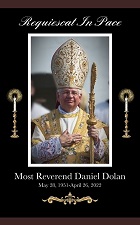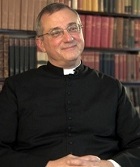'Material pope' or Barbarian Conqueror
First I want to emphasize one more time that my comments are in no way directed against Bishop Guerard des Laurier or anyone who holds his false "Thesis".
Argument:
"The post-Conciliar Church is a Catholic church, the structures of which remain Catholic, but are occupied by the modernist sect, whose representatives occupy the Chair of Peter and the Episcopal thrones."
Comment:
It is true that the heretics physically occupy the Vatican and St. Peter's Cathedral, as well as most churches, monasteries, universities, seminaries, schools, hospitals, and other sacred buildings and places around the world (these buildings and places still belong to the Catholic Church). But the mere fact that they have occupied Catholic buildings, lands and places does not make them Catholic, and its structures do not remain Catholic.
It is important to emphasize that when we speak of lands, buildings, etc., we mean immovable or movable properties.
But in theological and canonical meaning, the Church structures are not only lands, places, or buildings (ἐκκλησία, ecclesia - spiritual edifice, the term by which the New Testament holy writers denote the society founded by Our Lord Jesus Christ). These structures are made up of certain people who hold a certain office even being exiled, while their buildings and lands are seized by people of non-Catholic faith.
Usurping a church place or a building physically or materially is not the same as usurping a church structure. Therefore, an usurper of a church place or building is not the same as an usurper of a church structure.
Drinking from a papal chalice or eating from a papal plate, sitting in a papal chair or sleeping in a papal bed, or wearing papal robes does not turn a public heretic into a "material pope".
A public heretic can usurp Rome materially, but he cannot materially usurp the Throne of St. Peter.
According to Church Tradition, the Holy See is associated with Rome as a city in geographical meaning, where St. Peter was the first Pope and shed his blood for Christ. But according to the Divine Law, the Holy See, that is, the Throne of St. Peter is first associated with the person of St. Peter, his Faith and Office.
ARCHBISHOP FRANCIS PATRICK KENRICK explained:
“The city may be trodden down by the barbarian conqueror, and the Pontiff may perish; but there is a vitality in the See that renders its destruction impossible.”
(THE PRIMACY OF THE APOSTOLIC SEE VINDICATED, BY FRANCIS PATRICK KENRICK, ARCHBISHOP OF BALTIMORE, SEVENTH REVISED EDITION, BALTIMORE: PUBLISHED BY JOHN MURPHY & CO. 182 BALTIMORE STREET, 1875. pp. 238, 240)
When Rome (the city) is occupied by a public heretic (barbarian conqueror), this fact does not change the status of this heretic; he still is a barbarian conqueror, not a 'material pope'. In other words, being an occupant of Rome (the city) materially does not equal being an occupant of the Holy See (Office of St. Peter) materially.
The Catholic Church never had a teaching about an "office of heretical material successors of St. Peter" who do not have the Faith of Peter.
By Divine Law, the Throne (Office) of St. Peter is forever reserved for men who publicly profess the Faith of St. Peter. Therefore, after the death of St. Peter, and after the death of every one of his successors, the Church announces the VACANCY OF THE OFFICE OF ST. PETER (THE VACANCY OF THE OFFICE means lack of the OFFICE HOLDER), and only a Catholic man who publicly professes the Faith of St. Peter can be elected to this Office.
In the article, Bergoglio's got nothing to lose Fr. Anthony Cekada explained the "Sedevacantist thesis" as follows:
“The sedevacantist thesis arose from a need to explain how Paul VI, whom everyone at first recognized as a true pope when he was elected in 1963, could have used papal authority to promulgate doctrinal errors and evil laws.
The answer, as we now know, was to be found in a principle repeatedly laid down by pre-Vatican II theologians and canonists: A pope who became a public heretic automatically lost his office and papal authority. The principle applied on all fours to Paul VI, so one had a coherent explanation.
But what of his successors? Initially, many trads did not know exactly what to expect from John Paul I and John Paul II. (Believe it or not, the internet did not exist in those days, and information was hard to come by …) So sedevacantists tended to apply to both men the same theological principle they had previously applied to Paul VI — that is, the loss of office (authority) by a heretical pope who had validly obtained it.
In the 1990s, my own research into this question, first presented in "Traditionalists, Infallibility and the Pope", turned up many quotes to support this principle. At the same time, I encountered another theological twist: Not only did a public heretic cease to be pope, but also a public heretic could not become pope in the first place.”
“This general principle of divine law is even found in an ecclesiastical law promulgated by Pope Paul IV (1555–1559), who suspected that a cardinal who was a likely candidate for the papacy in the next conclave was in fact a secret heretic.
On 16 February 1559, therefore, Paul IV issued the Bull Cum ex Apostolatus Officio. The pontiff decreed that if ever it should ever appear that someone who was elected Roman Pontiff had beforehand “deviated from the Catholic faith or fallen into any heresy,” his election, even with the agreement and unanimous consent of all the cardinals would be “null, legally invalid and void.”
So the possibility that a conclave could elect a heretic is not some post-Vatican II sedevacantist fantasy. A real pope actually promulgated a law to prevent this possibility. And his decree laid down the same principle which the canonists quoted above said was divine law: a heretic cannot be validly elected pope.”
Conclusion
A barbarian conqueror cannot be validly elected pope.
Fr. V
|

